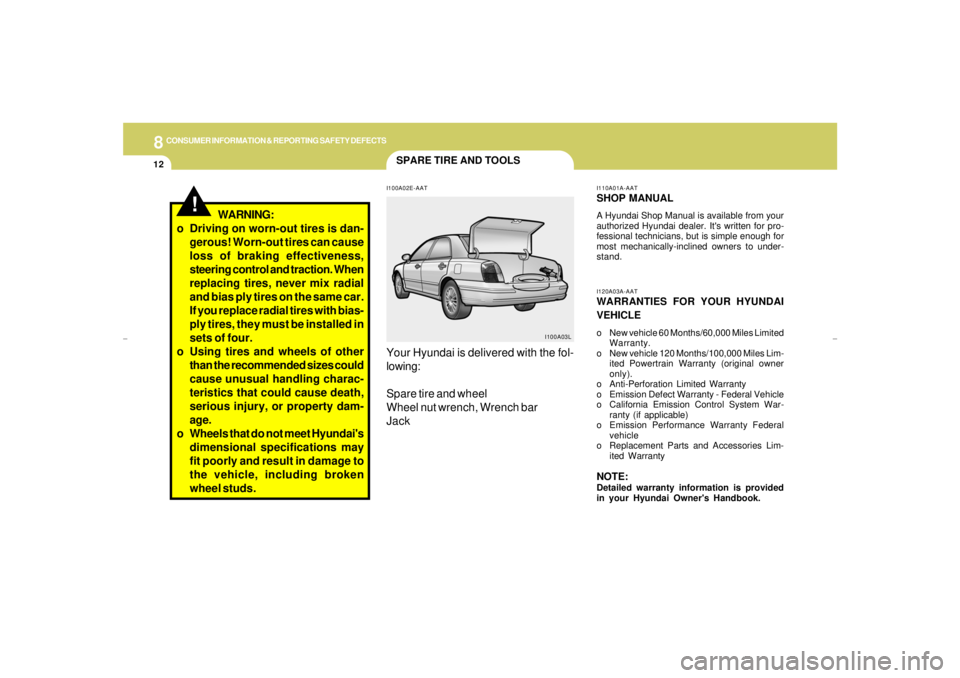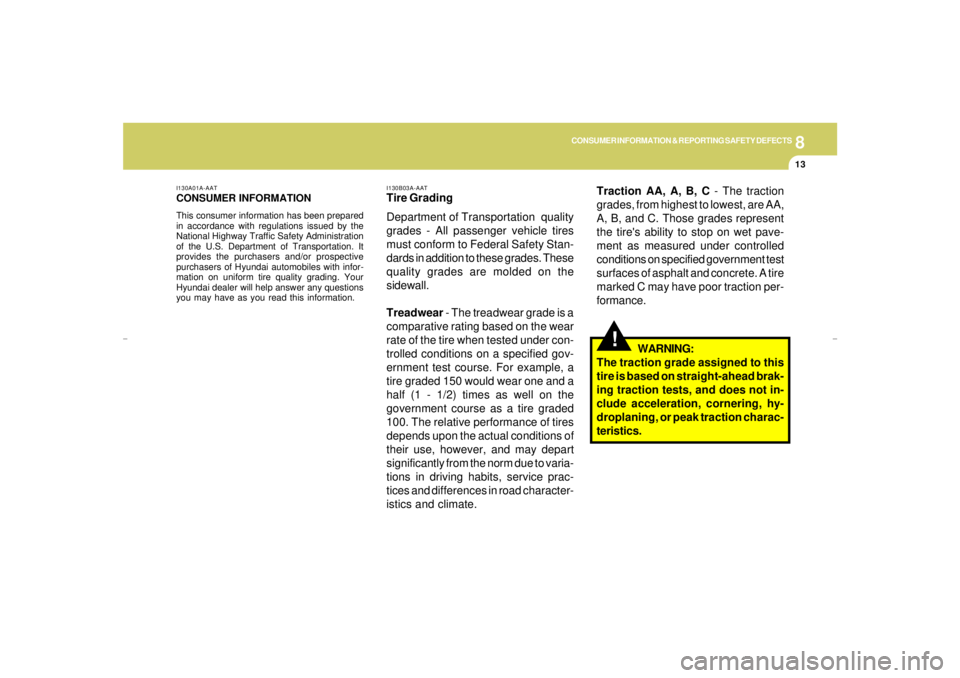2005 HYUNDAI XG350 traction control
[x] Cancel search: traction controlPage 218 of 247

7
EMISSION CONTROL SYSTEMS2
EMISSION CONTROL SYSTEMH010A02L-AATYour Hyundai is equipped with an emission
control system to meet all requirements of the
U.S. Environmental Protection Agency or Cali-
fornia Air Resources Board.
There are three emission control systems which
are as follows.
(1) Crankcase emission control system
(2) Evaporative emission control system
(3) Exhaust emission control system
In order to assure the proper function of the
emission control systems, it is recommended
that you have your car inspected and main-
tained by an authorized Hyundai dealer in ac-
cordance with the maintenance schedule in this
manual.
Caution for the Inspection and Maintenance
Test (3.5 V6 Vehicle with Traction Control
System)
After dynamometer testing is completed,
erase the ABS/TCS DTC(Diagnotic Trouble
Code) with a GST (Generic Scan Tool) or Hi-
Scan Pro.
H010B01A-AAT1. Crankcase Emission Control
SystemThe positive crankcase ventilation system is
employed to prevent air pollution caused by
blow-by gases being emitted from the crank-
case. This system supplies filtered air to the
crankcase through the air intake hose. Inside
the crankcase, the fresh air mixes with blow-by
gases, which then pass through the PCV valve
and into the induction system.
H010C01S-AAT2. Evaporative Emission Control (Includ-
ing ORVR: Onboard Refueling Vapor
Recovery) SystemThe Evaporative Emission Control System is
designed to prevent fuel vapors from escaping
into the atmosphere.
(The ORVR system is designed to allow the
vapors from the fuel tank to be loaded into
a canister while refueling at the gas station,
preventing the escape of fuel vapors into
the atmosphere.)CanisterFuel vapors generated inside the fuel tank are
absorbed and stored in the onboard canister.
When the engine is running, the fuel vapors
absorbed in the canister are drawn into the
induction system through the purge control
solenoid valve.Purge Control Solenoid Valve (PCSV)The purge control solenoid valve is controlled
by the Engine Control Module (ECM); when the
engine coolant temperature is low during idling,
the PCSV closes so that evaporated fuel is not
taken into the engine. After the engine warms-
up during ordinary driving, the PCSV opens to
introduce evaporated fuel to the engine.
xgflhma-7.p656/16/04, 2:57 PM 2
Page 231 of 247

8
CONSUMER INFORMATION & REPORTING SAFETY DEFECTS
11
I090A01A-AATWHEN TO REPLACE TIRES
The original tires on your car have tread
wear indicators. The tread wear indica-
tors appear when the tread depth is 0.06
in. (1.6 mm). The tire should be re-
placed when these appear as a solid bar
across two or more grooves of the
tread. Always replace your tires with
those of the recommended size. If you
change wheels, the new wheel's rim
width and offset must meet
Hyundai specification.
HGK248
0.06 in. (1.6 mm)
Wear indicator
I080A01A-AATTIRE TRACTION
Tire traction can be reduced if you drive
on worn tires, tires that are improperly
inflated or on slippery road surfaces.
Tires should be replaced when tread
wear indicators appear. To reduce the
possibility of losing control, slow down
whenever there is rain, snow or ice on
the road.I070A01A-AATTIRE BALANCING
A tire that is out of balance may affect
handling and tire wear. The tires on your
Hyundai were balanced before the car
was delivered but may need balancing
again during the years you own the car.
Whenever a tire is dismounted for re-
pair, it should be rebalanced before
being reinstalled
on the car.
!
WARNING:
o Do not use the temporary spare
tire for tire rotation.
o Do not mix bias ply and radial ply
tires under any circumstances.
This may cause unusual handling
characteristics that could result in
death, serious injury, or property
damage.
xgflhma-8.p656/16/04, 2:57 PM 11
Page 232 of 247

8
CONSUMER INFORMATION & REPORTING SAFETY DEFECTS
12
SPARE TIRE AND TOOLSI100A02E-AATYour Hyundai is delivered with the fol-
lowing:
Spare tire and wheel
Wheel nut wrench, Wrench bar
Jack
I100A03LI110A01A-AAT
SHOP MANUALA Hyundai Shop Manual is available from your
authorized Hyundai dealer. It's written for pro-
fessional technicians, but is simple enough for
most mechanically-inclined owners to under-
stand.I120A03A-AATWARRANTIES FOR YOUR HYUNDAI
VEHICLEo New vehicle 60 Months/60,000 Miles Limited
Warranty.
o New vehicle 120 Months/100,000 Miles Lim-
ited Powertrain Warranty (original owner
only).
o Anti-Perforation Limited Warranty
o Emission Defect Warranty - Federal Vehicle
o California Emission Control System War-
ranty (if applicable)
o Emission Performance Warranty Federal
vehicle
o Replacement Parts and Accessories Lim-
ited WarrantyNOTE:Detailed warranty information is provided
in your Hyundai Owner's Handbook.
!
WARNING:
o Driving on worn-out tires is dan-
gerous! Worn-out tires can cause
loss of braking effectiveness,
steering control and traction. When
replacing tires, never mix radial
and bias ply tires on the same car.
If you replace radial tires with bias-
ply tires, they must be installed in
sets of four.
o Using tires and wheels of other
than the recommended sizes could
cause unusual handling charac-
teristics that could cause death,
serious injury, or property dam-
age.
o Wheels that do not meet Hyundai's
dimensional specifications may
fit poorly and result in damage to
the vehicle, including broken
wheel studs.
xgflhma-8.p656/16/04, 2:57 PM 12
Page 233 of 247

8
CONSUMER INFORMATION & REPORTING SAFETY DEFECTS
13
!
Traction AA, A, B, C - The traction
grades, from highest to lowest, are AA,
A, B, and C. Those grades represent
the tire's ability to stop on wet pave-
ment as measured under controlled
conditions on specified government test
surfaces of asphalt and concrete. A tire
marked C may have poor traction per-
formance.
WARNING:
The traction grade assigned to this
tire is based on straight-ahead brak-
ing traction tests, and does not in-
clude acceleration, cornering, hy-
droplaning, or peak traction charac-
teristics.
I130A01A-AATCONSUMER INFORMATIONThis consumer information has been prepared
in accordance with regulations issued by the
National Highway Traffic Safety Administration
of the U.S. Department of Transportation. It
provides the purchasers and/or prospective
purchasers of Hyundai automobiles with infor-
mation on uniform tire quality grading. Your
Hyundai dealer will help answer any questions
you may have as you read this information.
I130B03A-AATTire Grading
Department of Transportation quality
grades - All passenger vehicle tires
must conform to Federal Safety Stan-
dards in addition to these grades. These
quality grades are molded on the
sidewall.
Treadwear - The treadwear grade is a
comparative rating based on the wear
rate of the tire when tested under con-
trolled conditions on a specified gov-
ernment test course. For example, a
tire graded 150 would wear one and a
half (1 - 1/2) times as well on the
government course as a tire graded
100. The relative performance of tires
depends upon the actual conditions of
their use, however, and may depart
significantly from the norm due to varia-
tions in driving habits, service prac-
tices and differences in road character-
istics and climate.
xgflhma-8.p656/16/04, 2:57 PM 13
Page 234 of 247

8
CONSUMER INFORMATION & REPORTING SAFETY DEFECTS
14
!
WARNING:
The temperature grade for this tire is
established for a tire that is properly
inflated and not overloaded. Exces-
sive speed, underinflation, or exces-
sive loading, either separately or in
combination, can cause heat buildup
and possible tire failure.
Uniform Tire Quality Grading - Qual-
ity grades can be found on the tire
sidewall between the tread shoulder
and the maximum section width.
For example:
Treadwear 200 Traction AA Tempera-
ture A Temperature A, B, C - The tempera-
ture grades are A (the highest), B, and
C, representing the tire's resistance to
the generation of heat and
its ability to dissipate heat when tested
under controlled conditions on a speci-
fied indoor laboratory test wheel. Sus-
tained high temperature can cause the
material of the tire to degenerate and
reduce tire life, and excessive tempera-
ture can lead to sudden tire failure. The
grade C corresponds to a level of perfor-
mance which all passenger car tires
must meet under the Federal Motor
Vehicle Safety Standard No. 109.
Grades B and A represent higher levels
of performance on the laboratory test
wheel than the minimum required by
law.
xgflhma-8.p656/16/04, 2:57 PM 14
Page 245 of 247

10
INDEX
5
P
Parking Brake...................................................................................1-65
Passenger Presence Detection ....................................................... 1-35
Power Outlet .....................................................................................1-53
Power Seat............................................................................ 1-13 ~ 1-14
Adjusting seat forward and rearward...........................................1-13
Adjusting seatbag angle ...............................................................1-14
Seat cushion height adjustment...................................................1-13
Power Steering Fluid Level ...............................................................6-20
R
Rear Window Defroster Switch .........................................................1-50
Replacement of light bulbs ...............................................................6-22
S
Seat
Front.................................................................................. 1-10 ~ 1-14
Seat Warmer .....................................................................................1-16
Seat Belts
3-Point system .................................................................. 1-20 ~ 1-23
Adjustable height.........................................................................1-20
Adjusting your seat belt ...............................................................1-22
Care of seat belts ........................................................................1-19
Precautions..................................................................................1-17
Spark Plugs........................................................................................ 6-8
Spectacle Case .................................................................................1-59
Speedometer.....................................................................................1-44Starting Procedure .............................................................................. 2-4
Steering Wheel Freeplay..................................................................6-16
Steering Wheel Tilt Lever .................................................................1-75
Stereo Radio Operation (H940A, H940C) .... 1-95 ~ 1-97, 1-106 ~ 1-108
Stereo Sound System ............................................................ 1-93 ~ 1-94
Sun Visor..........................................................................................1-73
Sunroof................................................................................... 1-55 ~ 1-57
T
Tachometer.......................................................................................1-44
Theft-Alarm system.................................................................... 1-7 ~ 1-9
Tires
Balancing.....................................................................................8-11
Chains..........................................................................................8-10
If you have a flat tire ...........................................................3-5 ~ 3-11
Information..................................................................................... 8-3
Pressures ....................................................................................... 8-4
Rotation........................................................................................8-10
Snow tires...................................................................................... 8-9
Spare tire ....................................................................................... 3-5
Traction........................................................................................8-11
Towing
A trailer (or vehicle).......................................................... 2-15 ~ 2-18
Emergency...................................................................................3-12
If your car must be towed ...........................................................3-11
Traction Control System.......................................................... 2-9 ~ 2-10
Transaxle
xgflhma-10.p656/16/04, 3:01 PM 5